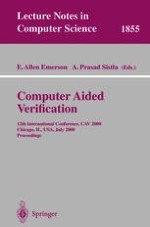This volume contains the proceedings of the 12th International Conference on Computer Aided Veri?cation (CAV 2000) held in Chicago, Illinois, USA during 15-19 July 2000. The CAV conferences are devoted to the advancement of the theory and practice of formal methods for hardware and software veri?cation. The con- rence covers the spectrum from theoretical foundations to concrete applications, with an emphasis on veri?cation algorithms, methods, and tools together with techniques for their implementation. The conference has traditionally drawn contributions from both researchers and practitioners in academia and industry. This year 91 regular research papers were submitted out of which 35 were - cepted, while 14 brief tool papers were submitted, out of which 9 were accepted for presentation. CAV included two invited talks and a panel discussion. CAV also included a tutorial day with two invited tutorials. Many industrial companies have shown a serious interest in CAV, ranging from using the presented technologies in their business to developing and m- keting their own formal veri?cation tools. We are very proud of the support we receive from industry. CAV 2000 was sponsored by a number of generous andforward-lookingcompaniesandorganizationsincluding:CadenceDesign- stems, IBM Research, Intel, Lucent Technologies, Mentor Graphics, the Minerva Center for Veri?cation of Reactive Systems, Siemens, and Synopsys. TheCAVconferencewasfoundedbyitsSteeringCommittee:EdmundClarke (CMU), Bob Kurshan (Bell Labs), Amir Pnueli (Weizmann), and Joseph Sifakis (Verimag).
